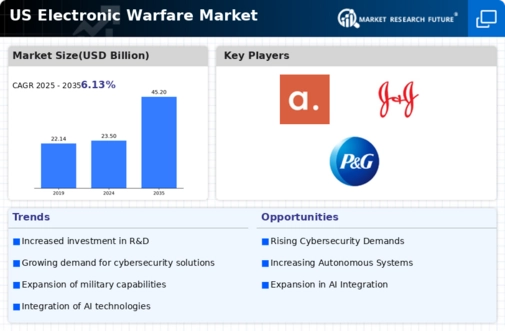The US Electronic Warfare Market is witnessing robust competition driven by advancements in technology and increasing defense budgets. With a growing focus on countering emerging threats in cyber and electronic domains, companies within the sector are constantly innovating their offerings to maintain a competitive edge. This market is characterized by a diverse mix of established players, each contributing to various segments including electronic countermeasures, electronic protection, and electronic support. The demand from military and defense sectors for comprehensive solutions that can operate seamlessly in contested environments underscores the urgency for companies to adapt and enhance their electronic warfare capabilities.
Strategic partnerships, research and development investments, and expanding service offerings are some of the key strategies organizations are employing to ensure sustained growth and relevance in this highly dynamic market.Raytheon Technologies stands out in the US Electronic Warfare Market due to its comprehensive portfolio and pioneering technologies. The company's strengths lie in its extensive experience in electronic systems and advanced battle management solutions, which cater specifically to the needs of the US military. Raytheon Technologies effectively leverages its research and development capabilities to create state-of-the-art systems that provide superior electronic countermeasures and protection solutions to combat various threats.
The company's reputation for reliability and performance has established it as a trusted partner for defense agencies. Additionally, Raytheon Technologies maintains a robust supply chain and support infrastructure, reinforcing its dominance in core electronic warfare products while ensuring rapid accessibility and maintenance for end-users.Lockheed Martin is a formidable player in the US Electronic Warfare Market, focusing on developing cutting-edge solutions and systems that address the evolving challenges faced by the armed forces. The company's key products in this domain include advanced radar systems, electronic attack technologies, and integrated electronic warfare systems that enhance situational awareness and strike capabilities.
Lockheed Martin's market presence is bolstered by its strategic investments in mergers and acquisitions, which have expanded its technological capabilities and product range. The company's strength lies in its commitment to innovation and its ability to deliver high-performance solutions tailored to the specific needs of US defense forces. Lockheed Martin’s proactive approach in exploring next-generation electronic warfare technologies ensures its longevity and relevance in the competitive landscape. As the needs for sophisticated electronic warfare grow, Lockheed Martin's continual evolution in services and solutions solidifies its position in the US market.













